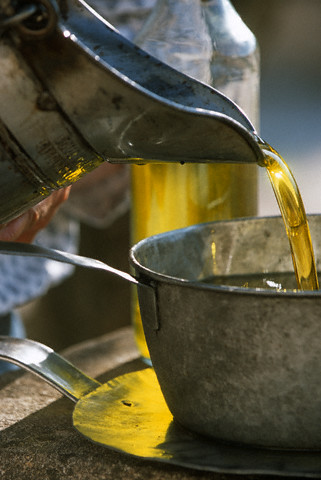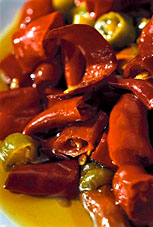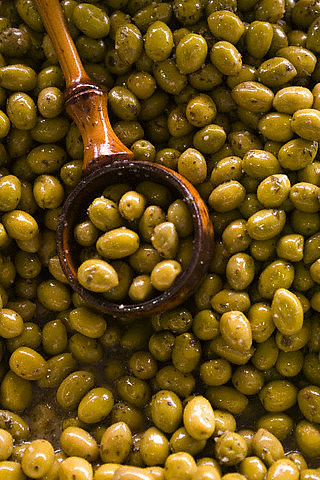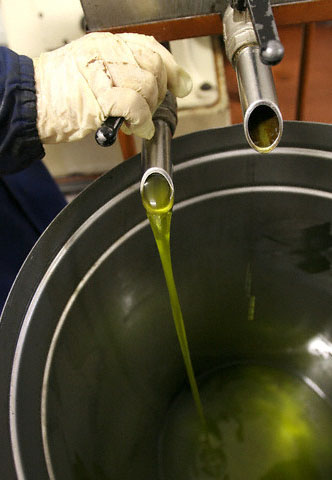Olives and Olive Oil Production in Sicily:
Think of olive oil as freshly squeezed juice from the drupe (a fruit with pit). Like a juice, it conserves the flavor, aroma, and vitamins of the olive fruit. Olive oil is uniquely the only vegetable oil that can be enjoyed immediately after being freshly pressed. The distinctive flavors and aromas of olive varieties are expressed in their olive oils (when made properly), just as flavors and perfumes of various grape varietals are expressed in their wines. Sicilian olive oil tends to have a strong flavor with a bit of spice and aromas of grass.
Olive oil is essential to the Italian and Sicilian diets. It is commonly seasoned with hot pepper, garlic, basil, rosemary, freshly cracked pepper (and fantastic for dipping hot, fresh bed) in addition to its many other uses (cooking, cosmetics, pharmaceuticals, soaps, traditional oil lamp fuel). While many consider Tuscany as the top producing region of olive oil in Italy, Sicily is working its way up the ladder and becoming a valid competitor. Of all of the regions in Italy producing their own homemade olive oils, Sicily has most probably been at it the longest (going back to the introduction of olive trees by the Greeks).
Sicily currently has four certified DOP olive growing regions and is waiting on certification for two other areas. Sicily commits thousands of acres of land to growing olives and the high quality olives produced are a result of fertile, volcanic (in parts) soil. While Carolea, Nocellara, and Biancolilla are the most widely cultivated olive varieties in Sicily, one can also find Crasto, Ogliarola Messinese, Cerasuola, La Minua, La Cavaleri, Tonda Iblea, Moresca, and Castiglione. The best pressing olives are Castiglione, Biancolilla, and the Nocellara varieties.
History of Olive Oil:
Native to the Mediterranean, olive trees originated in present day Turkey and Neolithic people are thought to have gathered the wild olive fruits. While it is unclear when acutal cultivation of the oil tree began, references in the Bible, the Iliad, and the Odyssey all imply its domestication without directly discussing it (compared to ancient accounts specifically referring to wine cultivation). Some claims denote Crete as the location of the first olive cultivation (archaeological evidence of olive oil dates back to 3500 BC, while oil procurement is thought to precede 4000 BC) while others name the Canaanites (modern day Israel) as the first producers of olive oil around 4500BC. It is clear that olive oil was important in Syria, Egypt, Crete and Canaan, being imported and exported and important for commerce and wealth—it was a staple of Minoan, Syrian and Egyptian life. It is the Hebrew Bible that holds the details of the first recorded olive oil elicitation during the Exodus from Egypt. Oil was extracted by hand-squeezing the olive fruit. Olive oil, or “liquid gold,” as Homer called it, was also an essential part of ancient Greek and Roman life. Aside from being eaten, olive oil was the basis of magic, medicine (heart ailments, stomach aches, hair loss, excessive perspiration), religious rituals, cosmetics (soap, lotion, perfume), and lamp and furnace fuel. Athletes and warriors would slather their bodies in oil for competitions and battles. It was also common to anoint oneself at the gymnasium and after bathing. This luxury of the wealthy was also used to routinely polish statues of the most important deities. One can still find ancient olive oil presses in use today in parts of the Eastern Mediterranean.
Present Day Consumption:
Locally produced olive oil is generally considered superior in countries that produce olive oil with 93% of European olive oil production coming from Spain, Italy, Greece & Turkey. Globally, Greeks are the biggest consumers of olive oil, followed by Spain & Italy, Tunisia, Portugal and Syria, with consumption on the rise in trailing Northern Europe and North America. However, U.S. demand for olive oil has exploded in the past decade and the U.S. is now the major importer of Italian olive oil.
How to Store Your Olive Oil:
Light, air and heat are olive oil’s top enemies. Exposure to these makes the oil go rancid. Keep your oil tightly sealed in a cool, dark place.
Tips for Selecting and Using Olive Oil:
1) Color variations in olive oil are normal (unless the oil is extremely light). Deep colors usually carry heavier flavors while lighter colors are the opposite. While most people consider olive oil to have a deep green color, olive oils may also be golden in color. (As with grapes, olives come in a variety of colors and create oils with similar coloring).
2) Check the date! Olive oil begins deteriorating after one year on the shelf (unless it’s really superior quality oil).
3) Purchase oil in the darkest (in not opaque) bottle possible.
4) After use, always wipe the mouth/neck of the olive oil bottle clean. Remaining oil that begins to go rancid can distort the flavors of the entire bottle.
5) Name brand or supermarket olive oil will always be inferior to smaller, farms or estates producing top quality olive oil.
6) As for frying, traditionally, the lightest oil possible is recommended so the food doesn’t take on the flavor of the oil. However, you may like the flavor olive oil adds and more importantly, olive oil deteriorates the least (as compared to other oils when frying) making it a better choice.
Grades of Olive Oil and Labeling:
Extra-virgin olive oil: best, least processed oil from first, cold-pressing of olives; acidity of 0.8% or less; cannot contain any refined oil; deemed “superior” by taste tests; often looks opaque or “cloudy”.
Virgin olive oil: from second pressing; acidity less than 2%; cannot contain any refined oil; deemed “good” by taste tests.
Pure olive oil: usually a blend of refined olive oil with one of the virgin types.
Olive oil: blend of refined and virgin oil; 1.5% acidity or less; generally bland.
Olive-pomace oil: blend of refined pomace olive oil and perhaps some virgin oil; edible but cannot be called olive oil; used in some restaurants.
Lampante oil: inedible; name comes from ancient use in oil lamps; used in industrial market.
Label wording:
“100% Pure Olive Oil”: usually lowest quality sold in stores.
“Made from refined olive oils”: taste & acidity results of chemical processes.
“Light olive oil”: another name for refined olive oil. (Lower fat olive oils don’t exist!)
“From hand-picked olives”: could mean better quality, since olives aren’t damaged as they can be with mechanical gathering.
“First cold press”: first oil from first press of olives; “cold” is important to retain the chemical integrity of the oil (which is changed when heated).
“Bottled in Italy” or “Packed in Italy”: not necessarily Italian olive oil; some labels specify the origins of the oil used, often mixtures.

|






|








